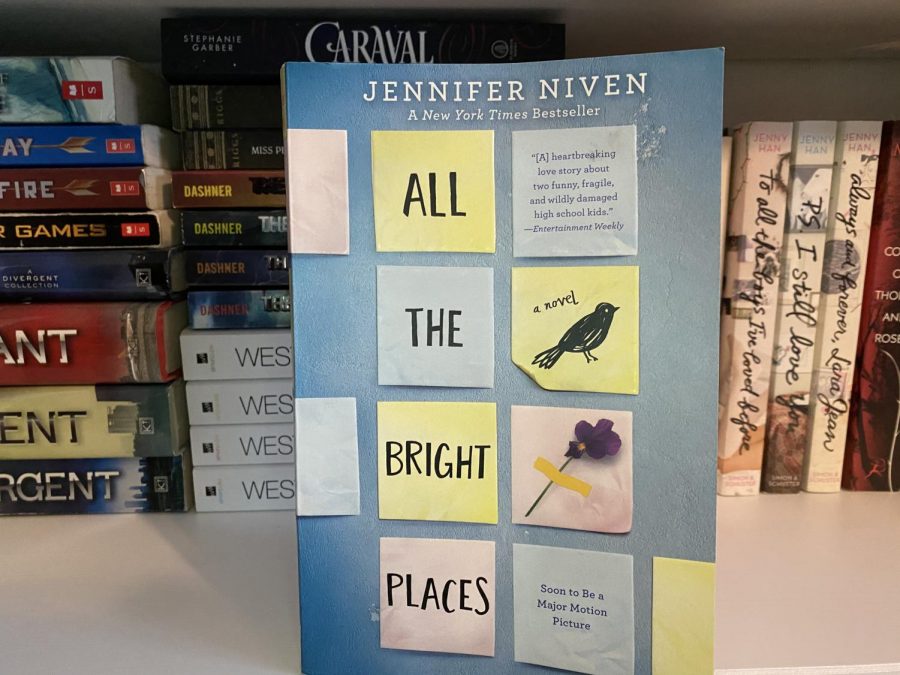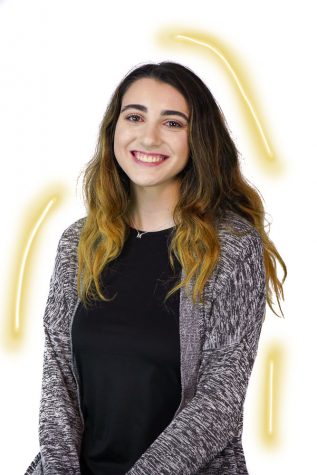Book Review: All the Bright Places
The love story between two teenagers who struggle to find the bright places in life
March 25, 2020
Violet Markey is counting down the days until graduation when she can finally leave her small town in Indiana. The grief of losing her sister still haunts her.
Theodore Finch is trying to stay awake. Every day he tries to find a reason to stay alive.
In All the Bright Places, Finch and Violet cross one another’s paths in the most unlikely circumstances. Who saves whom is unclear, but they meet in their darkest times, and by wandering the town, they see the bright places.
All the Bright Places is a stunning book about death, relationships, labels, and mental health. Author Jennifer Niven isn’t afraid to talk about suicide or death and writes about it so beautifully. By writing from both Violet and Finch’s perspectives, Niven lets you see inside the minds of damaged teenagers who are in love and trying to help themselves along the way.
Point-of-view stories can be hard to execute well. Trying to keep up with every character can be hard, especially if the author writes long chapters for every one of them.
Niven, however, does an amazing job in letting us see both Violet and Finch’s sides. I always knew what character’s perspective I was reading and I was never lost in a sea of different viewpoints. And let’s be honest, multiple points of view can be more interesting to read than just one.
Now, the story practically hits you in the face. Right away we met Finch and we see he’s on the ledge of the school’s bell tower. Niven opens the book with “Is today a good day to die?” and we learn all about his fascination with death. Violet, we soon learn, is also standing on the ledge. After they help each other off the ledge, the two go through their day like normal, until U.S. Geography class. The students are assigned to report on wonders of Indiana, and immediately Finch wants to work with Violet. It takes some convincing, but soon Violet agrees and so their adventures begin.
Violet is still dealing with the grief of losing her sister in a car accident and is blaming herself because she was in the car and didn’t die with her. Finch is a very happy, funny person on the outside; but, when reading his chapters we learn he keeps his dark, unhappy thoughts to himself. Throughout the book, we do see the growth of Violet as she learns to accept her circumstances and finally live her life. Finch is the one who pushed her back into the world through different adventures, wanderings, and just being there for her.
The plot focuses on the growth of the characters as they deal with challenges like grief and bullying. It also focuses on the evolution of a relationship from two students working on their project to two young adults in love. Throughout the story, the two help each other through the hard times and learn to always be there for each other, even when they’re physically apart.
Interestingly, just about every place the two characters wander to for their project is an actual place, such as the church and the bookmobile park. The author uses the real stories and names of John Ivers (who built the story’s roller coaster in his backyard) and Mike Carmichael (who has the world’s biggest ball of paint). Also, the website Violet is planning on launching, Germ Magazine, is a real site that is run by a handful of girls and boys. The website is like everything Violet plans for in the book, which made it fun when I actually browsed the website. The fact that the author uses real stories/projects makes the book feel much more special and authentic.
My favorite part of the whole story is the ending, which I won’t spoil here. All I’ll say is that it is unexpected and profound, and it will certainly make a strong impression on you.
Usually, I don’t read the author’s note or acknowledgments in books, but I wanted to learn more about Jennifer Niven and what she had to say about the book. When I read it, I could see why she wrote what she did. This book for her was different from what she normally writes (which is adult fiction/nonfiction) and much more personal. I learned that Niven has dealt with a lot of loss in her life. She was writing from the heart and did a lot of research. She said that, while writing the book, she learned that her own label is survivor of suicide. In my eyes, she is Violet and was most likely writing about some of her own experiences through Violet’s character.
It’s an especially good time to incorporate more reading in our lives, so if you’re looking for a book that is wise and emotionally gripping, I highly recommend you pick up All the Bright Places.













